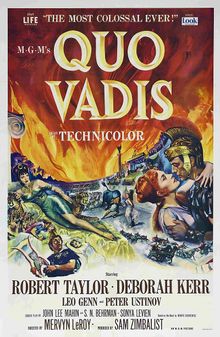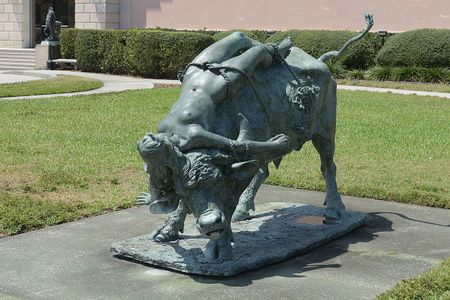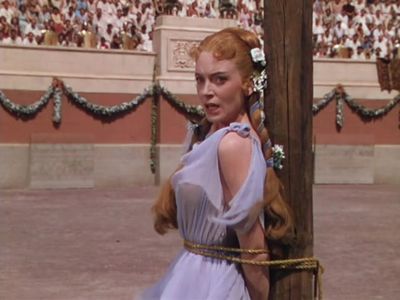Quo Vadis: Difference between revisions
m (Text replacement - " Academy Awards" to " Academy Awards") |
m (Text replacement - "Ben-Hur" to "''Ben Hur''") |
||
| Line 44: | Line 44: | ||
| notes = | | notes = | ||
}} | }} | ||
'''Quo Vadis?''' (Latin for "Where are you going?") is a 1951 American epic historical drama film made by [[Metro-Goldwyn-Mayer]] (MGM) in Technicolor. It was directed by Mervyn LeRoy and produced by Sam Zimbalist<ref group="Note">Zimbalist collapsed suddenly of a heart attack on set in Rome, Italy, during filming of Ben | '''Quo Vadis?''' (Latin for "Where are you going?") is a 1951 American epic historical drama film made by [[Metro-Goldwyn-Mayer]] (MGM) in Technicolor. It was directed by Mervyn LeRoy and produced by Sam Zimbalist<ref group="Note">Zimbalist collapsed suddenly of a heart attack on set in Rome, Italy, during filming of ''Ben Hur''. He was taken to his villa where he died</ref>, from a screenplay by John Lee Mahin, S.N. Behrman, and Sonya Levien, adapted from the novel Quo Vadis (1896) by the Polish Nobel Laureate author Henryk Sienkiewicz. The score is by Miklós Rózsa and the cinematography by Robert Surtees and William V. Skall. The title refers to an incident in the apocryphal Acts of Peter. | ||
The film stars Robert Taylor, Deborah Kerr, Leo Genn, and Peter Ustinov, and features Patricia Laffan, Finlay Currie, Abraham Sofaer, Marina Berti, Buddy Baer, and Felix Aylmer. Anthony Mann worked on the film for four weeks as an uncredited second-unit director. Sergio Leone was an uncredited assistant director of Italian extras. Future Italian stars Sophia Loren and Bud Spencer appeared as uncredited extras. The film was nominated for eight [[Academy Awards]] (though it won none), and it was such a huge box office success that it was credited with single-handedly rescuing MGM from the brink of bankruptcy. | The film stars Robert Taylor, Deborah Kerr, Leo Genn, and Peter Ustinov, and features Patricia Laffan, Finlay Currie, Abraham Sofaer, Marina Berti, Buddy Baer, and Felix Aylmer. Anthony Mann worked on the film for four weeks as an uncredited second-unit director. Sergio Leone was an uncredited assistant director of Italian extras. Future Italian stars Sophia Loren and Bud Spencer appeared as uncredited extras. The film was nominated for eight [[Academy Awards]] (though it won none), and it was such a huge box office success that it was credited with single-handedly rescuing MGM from the brink of bankruptcy. | ||
Revision as of 10:31, 28 June 2022
Quo Vadis? (Latin for "Where are you going?") is a 1951 American epic historical drama film made by Metro-Goldwyn-Mayer (MGM) in Technicolor. It was directed by Mervyn LeRoy and produced by Sam Zimbalist[Note 1], from a screenplay by John Lee Mahin, S.N. Behrman, and Sonya Levien, adapted from the novel Quo Vadis (1896) by the Polish Nobel Laureate author Henryk Sienkiewicz. The score is by Miklós Rózsa and the cinematography by Robert Surtees and William V. Skall. The title refers to an incident in the apocryphal Acts of Peter.
The film stars Robert Taylor, Deborah Kerr, Leo Genn, and Peter Ustinov, and features Patricia Laffan, Finlay Currie, Abraham Sofaer, Marina Berti, Buddy Baer, and Felix Aylmer. Anthony Mann worked on the film for four weeks as an uncredited second-unit director. Sergio Leone was an uncredited assistant director of Italian extras. Future Italian stars Sophia Loren and Bud Spencer appeared as uncredited extras. The film was nominated for eight Academy Awards (though it won none), and it was such a huge box office success that it was credited with single-handedly rescuing MGM from the brink of bankruptcy.
The story, set in ancient Rome during the final years of Emperor Nero's reign, AD 64–68, combines both historical and fictional events and characters and compresses the key events of that period into the space of only a few weeks. Its main theme is the Roman Empire’s conflict with Christianity and persecution of Christians in the final years of the Julio-Claudian line. Unlike his illustrious and powerful predecessor, Emperor Claudius, Nero proved corrupt and destructive, and his actions eventually threatened to destroy Rome's previously peaceful social order.
Plot
Marcus Vinicius is a Roman military commander and the legate of the XIV Gemina. Returning from wars in Britain and Gaul, he falls in love with Lygia, a devout Christian; in spite of this, he continually tries to win her affections. Though she grew up as the foster daughter of Aulus Plautius, a retired Roman general, Lygia is legally a Lygian hostage of Rome in the old general's care. Petronius, Marcus' uncle, persuades Nero to give her to his nephew as a reward for his services. Lygia resents this arrangement but eventually falls in love with Marcus.
Meanwhile, Nero's atrocities become increasingly outrageous and his behavior more irrational. After Nero burns Rome and blames the Christians, Marcus sets out to rescue Lygia and her family. Nero arrests them, along with all the other Christians, and condemns them to be slaughtered in his Circus; some are killed by lions. Petronius, Nero's most trusted advisor, warns him that the Christians will be celebrated as martyrs, but he cannot change the emperor's mind. Then, tired of Nero's insanity and suspecting that he may be about to turn on him, too, Petronius composes a letter to Nero expressing his derision for the emperor (which he previously had concealed to avoid being murdered by him) and commits suicide by severing an artery in his wrist. His slave girl Eunice (who has fallen in love with him) elects to die with him, despite being free. The Christian apostle Peter has also been arrested after returning to Rome in response to a sign from the Lord, and he marries Marcus and Lygia in the Circus prisons. Peter is later crucified upside-down, a form of execution conceived by Nero's Praetorian Guard as an expression of mockery of the crucifixion of Christ.
Poppaea, Nero's wife, who lusts after Marcus, devises a diabolical revenge for his rejection of her. Lygia is tied to a stake in the Circus and a wild bull is released into the arena. Lygia's bodyguard Ursus must attempt to kill the bull with his bare hands to save Lygia from being gored to death.
Movie version note:
- Although the 1951 version of Quo Vadis has Deborah Kerr as Lygia is tied to a stake. An earlier version (1924?) has her tied to the back of a bull requiring Ursus to fight the bull to free her. There is a bronze statue by Giuseppe Moretti of Lygea tied to a bull on display at the Ringling Museum Sarasota, Florida
- Lygia
'Lygia' in Quo Vadis (1924 version)
Marcus is taken to the emperor's box and forced to watch, to the outrage of his officers, who are among the spectators. Ursus is able to topple the bull, though, and break its neck. Massively impressed by Ursus's victory, the crowd exhorts Nero to spare the couple. He refuses to do so, even after four of his courtiers, Seneca, architect Phaon, poet Lucan, and musician Terpnos add their endorsement of the mob's demands. Marcus then breaks free of his bonds, leaps into the arena, and frees Lygia with the help of the loyal troops from his own legion. Marcus accuses Nero of burning Rome and announces that General Galba is at that moment marching on the city, intent on replacing Nero, and hails him as new Emperor of Rome.
The crowd revolts, now firmly believing that Nero, not the Christians, is responsible for the burning of Rome. Nero flees to his palace, where he strangles Poppaea, blaming her for inciting him to scapegoat the Christians. Then Acte, Nero's discarded mistress who is still in love with him, appears and offers him a dagger to end his own life before the mob storming the palace kills him. Nero cannot do it, so Acte helps him to push the dagger into his chest, and he dies.
Marcus, Lygia, and Ursus are now free, and they leave Rome for Marcus' estate in Sicily. By the roadside, Peter's crook, which he had left behind when he returned to Rome, has sprouted blossoms. A radiant light appears and a chorus intones, "I am the way, the truth, and the life," words spoken by Jesus (John 14:6, New Testament).
Production notes
The Wikipedia has extensive production notes about the making of this movie. It would do the reader well to read these notes. See Wikipedia Production notes
Other Film and television versions
- Quo Vadis?, a 1901 French film directed by Lucien Nonguet and Ferdinand Zecca
- Quo Vadis (1913 film), an Italian film directed by Enrico Guazzoni
- Quo Vadis (1924 film) an Italian film directed by Gabriellino d'Annunzio and Georg Jacoby
- Quo Vadis (1951 film) an American film directed by Mervyn LeRoy
- Quo Vadis (2001 film) a Polish film directed by Jerzy Kawalerowicz
- Quo Vadis? (miniseries), a 1985 miniseries directed by Franco Rossi
- Quo Vadis, Aida?, a 2020 film directed by Jasmila Žbanić
- "Quo Vadis?", a 2001 episode of the American television series ER
Notes
- ↑ Zimbalist collapsed suddenly of a heart attack on set in Rome, Italy, during filming of Ben Hur. He was taken to his villa where he died
- Infobox - Article updated with information from Wikipedia:
Chat rooms • What links here • Copyright info • Contact information • Category:Root


